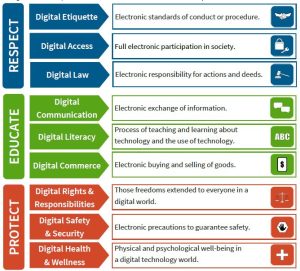5 Digital Media Literacy

Cyberbullying
1 in 8 adolescents admits to cyberbullying others, a behaviour that has escalated over recent years (WHO, 2024). This trend is particularly concerning given the digital world’s immense potential for learning and connection. Thus, investing in evidence-based interventions to combat cyberbullying supports adolescent well-being, reduces healthcare costs related to mental health issues and enhances educational outcomes (WHO, 2024). Research finds that prevention programs include whole-school environment involvement, parent/guardian involvement, well-trained facilitators, quality control mechanisms and attention to special and high-risk populations (WHO, 2022).

Strategies to prevent cyberbullying
- Prevention education focusing on internat safety programmes.
- Legistlation that includes enforcement and regulatory actions are more influential.
- Law enforcement and regulation with police activity can be a deterrent to crime.
- Public awareness campaigns about children;s online safety and targeted at potential offenders in various media environemnts.
- Helplines and hotlines viewed as a form of intervention or harm reduction.
- Safer environments, technology engineered solutions

In today’s digital era, technologies are continuously advancing, and students encounter numerous challenges online that may jeopardize their well-being. As a result, schools and educators are responsible for preparing students to be good digital citizens. According to Mike Ribble, digital citizenship is the safe, responsible, and ethical use of technology in a digital environment.
Mike Ribble identifies the nine key elements of digital citizenship as:

It includes safeguarding one’s privacy, mitigating the risks of online threats, digital literacy, and using technology respectfully and ethically. As the digital landscape evolves, it is critical for students to uphold the principles of what it means to be a responsible digital citizen. Online abuse, cyberbullying, spreading false news, and a lack of privacy concerns are all characteristics of bad digital citizenship. By fostering digital citizenship, educators can help students navigate online spaces and support their overall well-being.
Digital Media Literacy as a Tool:
Digital media literacy refers to the ability to critically and responsibly access, understand, and participate in media content such as music, TV, video games, and social media. The media has a huge influence on youth since they spend a significant amount of time on it. As a result, they must develop skills that enable them to navigate digital media in a safe and responsible manner. These skills enable youth to distinguish between authentic and fake news, grasp complex societal issues, and protect their privacy and well-being.
Key Skills and Competencies (Kellner & Share, 2005):

Fake news:
Fake news is false or misleading information that cannot be verified. It is frequently done with the intention of damaging a person’s or entity’s reputation. It is circulated as propaganda to deceive the public and is sometimes used as clickbait for advertising purposes. Nonetheless, fake news has major consequences for everyone concerned.

The spread of fake news was probably at its peak during the Covid-19 outbreak. Public health officials were not only dealing with a new illness but also fighting against conspiracy theorists propagating disinformation online.
Rocha et al. (2021) discovered that exposure to infodemic knowledge on the COVID-19 epidemic generated feelings of fear and worry, as well as an increase in the prevalence of depressive and anxious symptoms.
Similarly, WHO research conducted during the pandemic discovered that the distribution of inaccurate or misleading health content on social media caused people to experience mental, social, political, and economic suffering.
MIT Study on Fake News on Twitter
- A study by MIT discovered that fake news spreads 6 times quicker on Twitter than truthful news.
- Fake news consistently receives between 1,000 and 100,000 impressions, whereas accurate news rarely exceeds 1,000.
Some commenters argue that foreign bots drive the spread of fake news, but the study reveals that humans are more to blame for spreading fake news.
Stanford study on media literacy
- Identified tech-savvy high school students lack the skills to judge the reliability of information online.
- 3,446 students participated in a national survey on media literacy, the ability to judge Twitter feeds, comments, and other digital messages shared online.
Key Findings:
- 23% of students could not distinguish between stories and advertisements.
- 52% of respondents believed a fraudulent video circulating on Twitter depicting ballot stuffing during the 2016 American elections.
References
Breakstone, J., Smith, M., Wineburg, S., Rapaport, A., Carle, J., Garland, M., & Saavedra, A. (2016.). Students’ Civic Online Reasoning: A National Portrait. Stanford Digital Repository. https://purl.stanford.edu/gf151tb4868
Nascimento, I. J. B., Pizarro, A. B., Almeida, J. M., Azzopardi-Muscat, N., Gonçalves, M. A., Björklund, M., & Novillo-Ortiz, D. (2022). Infodemics and health misinformation: a systematic review of reviews. Bulletin of the World Health Organization, 100(9), 544.
OECD. (2022). Cyberbullying: An overview of research and policies in OECD countries, Retrieved from https://one.oecd.org/document/EDU/WKP(2022)8/en/pdf
Ribble, M. (2012). Digital citizenship for educational change. Kappa Delta Pi Record, 48(4), 148-151.
Rocha, Y. M., De Moura, G. A., Desidério, G. A., De Oliveira, C. H., Lourenço, F. D., & de Figueiredo Nicolete, L. D. (2021). The impact of fake news on social media and its influence on health during the COVID-19 pandemic: A systematic review. Journal of Public Health, 1-10.
Vosoughi, S., Roy, D., & Aral, S. (2018). The spread of true and false news online. science, 359(6380), 1146-1151.
WHO. (2022). What works to prevent online violence against children, World Health Organization, https://iris.who.int/bitstream/handle/10665/364706/9789240062061-eng.pdf?sequence=1
WHO. (2024). One in six school-aged children experiences cyberbullying, finds new WHO/Europe study. World Health Organization, https://www.who.int/azerbaijan/news/item/27-03-2024-one-in-six-school-aged-children-experiences-cyberbullying–finds-new-who-europe-study. Investing
